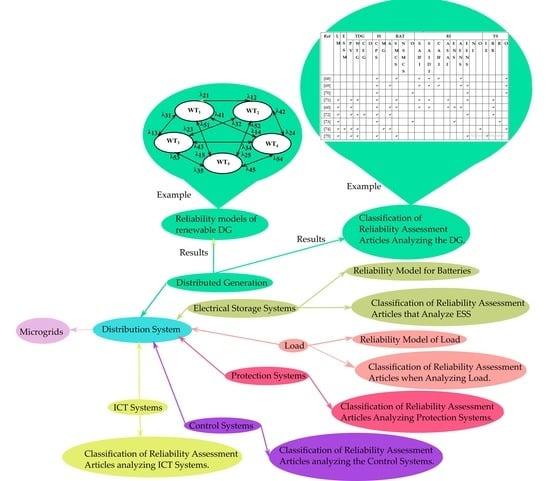Reliability Evaluation in Distribution Networks with Microgrids: Review and Classification of the Literature
Abstract
1. Introduction
2. Theoretical Framework
2.1. Structure of the Power System
2.2. Reliability Assessment in the Power System
2.3. Adequacy Indexes of the Distribution Systems
2.4. Test Systems
2.5. Reliability Assessment Techniques of DS
3. Microgrids and Their Subsystems
3.1. Smart Grids
3.2. Microgrids
MG Architectures
3.3. Distributed Generation
3.4. Loads
3.5. Energy Storage Systems
3.6. Protection Systems
3.7. Control Systems
3.8. Information and Communication Technology Systems
3.9. Power Electronic Devices
4. Reliability Assessment in Distribution Systems with Microgrids: Issues and Opportunities
4.1. Why Is the Reliability Assessment of DS with Microgrids Important?
4.2. Reliability Assessment in SGs
4.3. Reliability Assessment in DS When MGs Are Introduced
Reliability Assessment of MG Architectures
4.4. Reliability Assessment in Distribution Systems and MGs with Distributed Generation
4.4.1. Reliability Models of Renewable DG Units WTG and PV
4.4.2. Probability Model of the WTG Output Power
4.4.3. Probability Model of the Output Power of the PV
4.4.4. Classification of Reliability Assessment Studies in Modern Power Systems Focused on DG
4.5. Reliability Assessment in MGs Analyzing the Influence on Loads
4.5.1. Load Probability Model
4.5.2. Classification of RA Studies in MG focused on the Load
4.6. Reliability Assessment in MGs, Analyzing the Influence of the ESS
4.6.1. Probabilistic Model for Batteries
4.6.2. Classification of Reliability Assessment Studies in MG, Focused on ESS
4.7. Classification of Reliability Assessment Studies in MG Focused on Protection Systems
4.8. Classification of Reliability Assessment Studies in MG Focused on Control Systems
4.9. Classification of Reliability Assessment Studies in MG Focused on ICT Systems
4.10. RA Studies in MGs Analyzing the Influence the Power Electronic Systems
5. Discussion
Supplementary Materials
Author Contributions
Funding
Acknowledgments
Conflicts of Interest
References
- Yoldaş, Y.; Önen, A.; Muyeen, S.; Vasilakos, A.V.; Alan, I. Enhancing smart grid with microgrids: Challenges and opportunities. Renew. Sustain. Energy Rev. 2017, 72, 205–214. [Google Scholar] [CrossRef]
- Conti, S.; Rizzo, S.A.; El-Saadany, E.F.; Essam, M.; Atwa, Y.M. Reliability Assessment of Distribution Systems Considering Telecontrolled Switches and Microgrids. IEEE Trans. Power Syst. 2013, 29, 598–607. [Google Scholar] [CrossRef]
- Celli, G.; Ghiani, E.; Pilo, F.; Soma, G.G. Reliability assessment in smart distribution networks. Electr. Power Syst. Res. 2013, 104, 164–175. [Google Scholar] [CrossRef]
- Smith, M.; Ton, D. Key Connections: The U.S. Department of Energys Microgrid Initiative. IEEE Power Energy Mag. 2013, 11, 22–27. [Google Scholar] [CrossRef]
- Li, Q.; Xu, Z.; Yang, L. Recent advancements on the development of microgrids. J. Mod. Power Syst. Clean Energy 2014, 2, 206–211. [Google Scholar] [CrossRef]
- Soshinskaya, M.; Crijns-Graus, W.H.; Guerrero, J.M.; Vasquez, J.C. Microgrids: Experiences, barriers and success factors. Renew. Sustain. Energy Rev. 2014, 40, 659–672. [Google Scholar] [CrossRef]
- Fu, Q.; Nasiri, A.; Solanki, A.; Bani-Ahmed, A.; Weber, L.; Bhavaraju, V. Microgrids: Architectures, Controls, Protection, and Demonstration. Electr. Power Compon. Syst. 2015, 43, 1453–1465. [Google Scholar] [CrossRef]
- Sabzehgar, R. A review of AC/DC microgrid-developments, technologies, and challenges. In Proceedings of the 2015 IEEE Green Energy and Systems Conference, Long Beach, CA, USA, 9 November 2015. [Google Scholar]
- Hirsch, A.; Parag, Y.; Guerrero, J.M. Microgrids: A review of technologies, key drivers, and outstanding issues. Renew. Sustain. Energy Rev. 2018, 90, 402–411. [Google Scholar] [CrossRef]
- Choudhury, S. A comprehensive review on issues, investigations, control and protection trends, technical challenges and future directions for Microgrid technology. Int. Trans. Electr. Energy Syst. 2020, 30, 1–16. [Google Scholar] [CrossRef]
- Billinton, R. Bibliography on the Application of Probability Methods in Power System Reliability Evaluation. IEEE Trans. Power Appar. Syst. 1972, 649–660. [Google Scholar] [CrossRef]
- Allan, R.N.; Billinton, R.; Shahidehpour, S.; Singh, C. Bibliography on the Application of Probability Methods in Power System Reliability evaluation. IEEE Trans. Power Syst. 1988, 3, 1555–1564. [Google Scholar] [CrossRef]
- Allan, R.N.; Billinton, R.; Breipohl, A.M.; Grigg, C.H. Bibliography on the Application of Probability Methods in Power System Reliability Evaluation. IEEE Trans. Power Syst. 1994, 9, 41–49. [Google Scholar] [CrossRef]
- Allan, R.; Billinton, R.; Breipohl, A.; Grigg, C. Bibliography on the application of probability methods in power system reliability evaluation. IEEE Trans. Power Syst. 1999, 14, 51–57. [Google Scholar] [CrossRef]
- Billinton, R.; Fotuhi-Firuzabad, M.; Bertling, L.B. Bibliography on the application of probability methods in power system reliability evaluation 1996–1999. IEEE Trans. Power Syst. 2001, 16, 595–602. [Google Scholar] [CrossRef]
- Lin, J.; Cheng, L.; Chang, Y.; Zhang, K.; Shu, B.; Liu, G. Reliability based power systems planning and operation with wind power integration: A review to models, algorithms and applications. Renew. Sustain. Energy Rev. 2014, 31, 921–934. [Google Scholar] [CrossRef]
- Borges, C.L.T. An overview of reliability models and methods for distribution systems with renewable energy distributed generation. Renew. Sustain. Energy Rev. 2012, 16, 4008–4015. [Google Scholar] [CrossRef]
- Mohamad, F.; Teh, J. Impacts of Energy Storage System on Power System Reliability: A Systematic Review. Energies 2018, 11, 1749. [Google Scholar] [CrossRef]
- Khan, B.; Alhelou, H.H.; Mebrahtu, F. A holistic analysis of distribution system reliability assessment methods with conventional and renewable energy sources. AIMS Energy 2019, 7, 413–429. [Google Scholar] [CrossRef]
- Escalera, A.; Hayes, B.; Prodanović, M. A survey of reliability assessment techniques for modern distribution networks. Renew. Sustain. Energy Rev. 2018, 91, 344–357. [Google Scholar] [CrossRef]
- Liberati, A.; Altman, D.G.; Tetzlaff, J.; Mulrow, C.D.; Gøtzsche, P.C.; Ioannidis, J.P.; Clarke, M.; Devereaux, P.; Kleijnen, J.; Moher, D. The PRISMA statement for reporting systematic reviews and meta-analyses of studies that evaluate health care interventions: Explanation and elaboration. J. Clin. Epidemiol. 2009, 62, e1–e34. [Google Scholar] [CrossRef]
- Elmakias, D. New Computational Methods in Power System Reliability; Springer: Berlin, Germany, 2008. [Google Scholar]
- Faulin, J.; Juan, A.; Martorell, S.; Ramírez, J. Simulation Methods for Reliability and Availability of Complex Systems; Springer: London, UK, 2010. [Google Scholar]
- Billinton, R.; Li, W. Reliability Assessment of Electric Power Systems Using Monte Carlo Methods; Springer Science+Business Media, LLC.: New York, NY, USA, 1994. [Google Scholar]
- Billinton, R.; Allan, R.N. Reliability Evaluation of Power Systems; Plenum Press: New York, NY, USA, 1996. [Google Scholar]
- Billinton, R.; Allan, R.N. Reliability Evaluation of Engineering Systems; Springer Science+Business Media, LLC.: New York, NY, USA, 1992. [Google Scholar]
- Blischke, W.R.; Murthy, D.N.P. Reliability: Modeling, Prediction and Optimization; JOHN WILEY & SONS, INC.: New York, NY, USA, 2000. [Google Scholar]
- Elgenedy, M.A.; Massoud, A.M.; Ahmed, S. Smart grid self-healing: Functions, applications, and developments. In Proceedings of the 2015 First Workshop on Smart Grid and Renewable Energy, Doha, Qatar, 22 March 2015. [Google Scholar]
- El-Hawary, M.E. The Smart Grid—State-of-the-art and Future Trends. Electr. Power Compon. Syst. 2014, 42, 239–250. [Google Scholar] [CrossRef]
- Bhatt, J.; Shah, V.; Jani, O. An instrumentation engineer’s review on smart grid: Critical applications and parameters. Renew. Sustain. Energy Rev. 2014, 40, 1217–1239. [Google Scholar] [CrossRef]
- Bari, A.; Jiang, J.; Saad, W.; Jaekel, A. Challenges in the Smart Grid Applications: An Overview. Int. J. Distrib. Sens. Netw. 2014, 10. [Google Scholar] [CrossRef]
- IqtiyaniIlham, N.; Hasanuzzaman, M.; Hosenuzzaman, M. European smart grid prospects, policies, and challenges. Renew. Sustain. Energy Rev. 2017, 67, 776–790. [Google Scholar] [CrossRef]
- Selvam, M.M.; Gnanadass, R.; Padhy, N.P. Initiatives and technical challenges in smart distribution grid. Renew. Sustain. Energy Rev. 2016, 58, 911–917. [Google Scholar] [CrossRef]
- Vineetha, C.P.; Babu, C.A. Smart grid challenges, issues and solutions. In Proceedings of the 2014 International Conference on Intelligent Green Building and Smart Grid, Taipei, Taiwan, 23–25 April 2014. [Google Scholar]
- Lasseter, R.H.; Paigi, P. Microgrid: A conceptual solution. In Proceedings of the 2004 IEEE 35th Annual Power Electronics Specialists Conference, Aachen, Germany, 20–25 June 2004. [Google Scholar]
- Lasseter, R.H. Smart Distribution: Coupled Microgrids. Proc. IEEE 2011, 99, 1074–1082. [Google Scholar] [CrossRef]
- De Quevedo, P.M.; Contreras, J.; Mazza, A.; Chicco, G.; Porumb, R. Modeling and reliability assessment of microgrids including renewable distributed generation. In Proceedings of the 2016 IEEE 16th International Conference on Environment and Electrical Engineering, Florence, Italy, 7–10 June 2016. [Google Scholar]
- Kueck, J.D.; Kirby, B.J. The Distribution System of the Future. Electr. J. 2003, 16, 78–87. [Google Scholar] [CrossRef]
- Khodayar, M.E.; Barati, M.; Shahidehpour, M. Integration of High Reliability Distribution System in Microgrid Operation. IEEE Trans. Smart Grid 2012, 3, 1997–2006. [Google Scholar] [CrossRef]
- Nikmehr, N.; Ravadanegh, S.N. Reliability evaluation of multi-microgrids considering optimal operation of small scale energy zones under load-generation uncertainties. Int. J. Electr. Power Energy Syst. 2016, 78, 80–87. [Google Scholar] [CrossRef]
- Unamuno, E.; Barrena, J.A. Hybrid ac/dc microgrids—Part I: Review and classification of topologies. Renew. Sustain. Energy Rev. 2015, 52, 1251–1259. [Google Scholar] [CrossRef]
- Justo, J.J.; Mwasilu, F.; Lee, J.; Jung, J.-W. AC-microgrids versus DC-microgrids with distributed energy resources: A review. Renew. Sustain. Energy Rev. 2013, 24, 387–405. [Google Scholar] [CrossRef]
- Planas, E.; Andreu, J.; Gárate, J.I.; De Alegría, I.M.; Ibarra, E. AC and DC technology in microgrids: A review. Renew. Sustain. Energy Rev. 2015, 43, 726–749. [Google Scholar] [CrossRef]
- Patrao, I.; Figueres, E.; Garcerá, G.; González-Medina, R. Microgrid architectures for low voltage distributed generation. Renew. Sustain. Energy Rev. 2015, 43, 415–424. [Google Scholar] [CrossRef]
- Dragicevic, T.; Lu, X.; Vasquez, J.C.; Guerrero, J.M. DC Microgrids—Part II: A Review of Power Architectures, Applications, and Standardization Issues. IEEE Trans. Power Electron. 2016, 31, 3528–3549. [Google Scholar] [CrossRef]
- Ackermann, T.; Andersson, G.; Söder, L. Distributed generation: A definition. Electr. Power Syst. Res. 2001, 57, 195–204. [Google Scholar] [CrossRef]
- Makandar, M.; Atla, C.S.R.; Velamuri, S. Reliability assessment of distribution system with renewable Distributed Generation. In Proceedings of the Biennial International Conference on Power and Energy Systems: Towards Sustainable Energy, Bengaluru, India, 21–23 January 2016. [Google Scholar]
- Jing, W.; Lai, C.H.; Wong, S.H.W.; Wong, M.L.D. Battery-supercapacitor hybrid energy storage system in standalone DC microgrids: A review. IET Renew. Power Gener. 2017, 11, 461–469. [Google Scholar] [CrossRef]
- Memon, A.A.; Kauhaniemi, K. A critical review of AC Microgrid protection issues and available solutions. Electr. Power Syst. Res. 2015, 129, 23–31. [Google Scholar] [CrossRef]
- Brearley, B.J.; Prabu, R.R. A review on issues and approaches for microgrid protection. Renew. Sustain. Energy Rev. 2017, 67, 988–997. [Google Scholar] [CrossRef]
- Mahmoud, M.S.; Alyazidi, N.M.; Abouheaf, M.I. Adaptive intelligent techniques for microgrid control systems: A survey. Int. J. Electr. Power Energy Syst. 2017, 90, 292–305. [Google Scholar] [CrossRef]
- Bouzid, A.M.; Guerrero, J.M.; Cheriti, A.; Bouhamida, M.; Sicard, P.; Benghanem, M. A survey on control of electric power distributed generation systems for microgrid applications. Renew. Sustain. Energy Rev. 2015, 44, 751–766. [Google Scholar] [CrossRef]
- Hauser, C.; Bakken, D.; Bose, A. A failure to communicate: Next generation communication requirements, technologies, and architecture for the electric power grid. IEEE Power Energy Mag. 2005, 3, 47–55. [Google Scholar] [CrossRef]
- Kalalas, C.; Thrybom, L.; Alonso-Zarate, J. Cellular Communications for Smart Grid Neighborhood Area Networks: A Survey. IEEE Access 2016, 4, 1469–1493. [Google Scholar] [CrossRef]
- Babu, S.; Hilber, P.; Jurgensen, J.H.; Babu, S. On the status of reliability studies involving primary and secondary equipment applied to power system. In Proceedings of the 2014 International Conference on Probabilistic Methods Applied to Power Systems, Durham, UK, 7–10 July 2014. [Google Scholar]
- Zhang, P.; Li, W.; Li, S.; Wang, Y.; Xiao, W. Reliability assessment of photovoltaic power systems: Review of current status and future perspectives. Appl. Energy 2013, 104, 822–833. [Google Scholar] [CrossRef]
- Boroyevich, D.; Cvetkovic, I.; Dong, D.; Burgos, R.; Wang, F.; Lee, F. Future electronic power distribution systems a contemplative view. In Proceedings of the 2010 12th International Conference on Optimization of Electrical and Electronic Equipment, Brasov, Romania, 20–22 May 2010. [Google Scholar]
- Aljohani, T.M.; Beshir, M.J. Distribution System Reliability Analysis for Smart Grid Applications. Smart Grid Renew. Energy 2017, 8, 240–251. [Google Scholar] [CrossRef]
- Aljohani, T.M.; Beshir, M.J. Matlab Code to Assess the Reliability of the Smart Power Distribution System Using Monte Carlo Simulation. J. Power Energy Eng. 2017, 5, 30–44. [Google Scholar] [CrossRef]
- Lei, H.; Singh, C. Non-Sequential Monte Carlo Simulation for Cyber-Induced Dependent Failures in Composite Power System Reliability Evaluation. IEEE Trans. Power Syst. 2016, 32, 1. [Google Scholar] [CrossRef]
- Xiang, Y.; Wang, L.; Fu, T. A preliminary study of power system reliability considering cloud service reliability. In Proceedings of the 2014 International Conference on Power System Technology, Chengdu, China, 20–22 October 2014. [Google Scholar]
- Li, G.; Bie, Z.; Xie, H.; Lin, Y. Customer satisfaction based reliability evaluation of active distribution networks. Appl. Energy 2016, 162, 1571–1578. [Google Scholar] [CrossRef]
- Maleki, B.; Gandomkar, M.; Maleki, T.; Gandoman, F.H. Method of evaluating reliability of microgrids in Island mode by using load prioritization. In Proceedings of the 2014 19th Conference on Electrical Power Distribution Networks, Tehran, Iran, 6–7 May 2014. [Google Scholar]
- Costa, P.M.; Matos, M.A. Reliability of distribution networks with microgrids. In Proceedings of the 2005 IEEE Russia Power Tech, St. Petersburg, Russia, 27–30 June 2005. [Google Scholar]
- Conti, S.; Nicolosi, R.; Rizzo, S.A. Generalized Systematic Approach to Assess Distribution System Reliability with Renewable Distributed Generators and Microgrids. IEEE Trans. Power Deliv. 2012, 27, 261–270. [Google Scholar] [CrossRef]
- Syrri, A.L.A.; Martinez Cesena, E.A.; Mancarella, P. Contribution of Microgrids to distribution network reliability. In Proceedings of the 2015 IEEE Eindhoven Power Tech, Eindhoven, The Netherlands, 29 June–2 July 2015. [Google Scholar] [CrossRef]
- Sagar, E.V.; Kumar, G.K. Reliability improvement of radial distribution systems using Microgrids placed on distributors. In Proceedings of the 2015 Conference on Power, Control, Communication and Computational Technologies for Sustainable Growth, Kurnool, India, 11–12 December 2015. [Google Scholar]
- Lovelady, D.; Yang, B.; Natti, S.; Mueller, H.; Tao, L. A scenario driven reliability assessment approach for microgrids. In Proceedings of the 2013 IEEE Power & Energy Society General Meeting, Vancouver, BC, Canada, 21–25 July 2013. [Google Scholar]
- Huang, X.; Shen, Y.; Zeng, F.; Chen, C.; Cao, Y. Reliability evaluation of microgrid cluster based on Monte-Carlo hierarchical dynamic reliability model. In Proceedings of the 10th IET International Conference on Advances in Power System Control, Operation & Management, Hong Kong, China, 8–12 November 2015. [Google Scholar]
- Chen, Q.; Mili, L. Optimal placement and sizing of microgrids in composite reliability of a deregulated power system. Int. J. Crit. Infrastruct. 2016, 12, 37. [Google Scholar] [CrossRef]
- Conti, S.; Rizzo, S.A. Monte Carlo Simulation by Using a Systematic Approach to Assess Distribution System Reliability Considering Intentional Islanding. IEEE Trans. Power Deliv. 2015, 30, 64–73. [Google Scholar] [CrossRef]
- Fan, T.; Du, S.; Liu, K.; Su, J.; Liu, Y. Reliability evaluation based on Monte Carlo simulation considering islanded operation in distribution network with micogrid. In Proceedings of the International Conference on Renewable Power Generation, Beijing, China, 17–18 October 2015. [Google Scholar]
- Liang, H.; Su, J.; Liu, S. Reliability evaluation of distribution system containing microgrid. In Proceedings of the 2010 China International Conference on Electricity Distribution, Nanjing, China, 13–16 September 2010. [Google Scholar]
- Wang, C.; Jiao, B.; Guo, L.; Yuan, K.; Sun, B. Optimal planning of stand-alone microgrids incorporating reliability. J. Mod. Power Syst. Clean Energy 2014, 2, 195–205. [Google Scholar] [CrossRef]
- Xu, X.; Mitra, J.; Wang, T.; Mu, L. Reliability Evaluation of a Microgrid Considering Its Operating Condition. J. Electr. Eng. Technol. 2016, 11, 47–54. [Google Scholar] [CrossRef]
- Li, G.; Kou, Y.; Jiang, J.; Lin, Y.; Bie, Z. Researches on the reliability evaluation of integrated energy system based on Energy Hub. In Proceedings of the 2016 China International Conference on Electricity Distribution, Xi’an, China, 10–13 August 2016. [Google Scholar]
- Wang, S.; Li, Z.; Wu, L.; Shahidehpour, M.; Li, Z. New Metrics for Assessing the Reliability and Economics of Microgrids in Distribution System. IEEE Trans. Power Syst. 2013, 28, 2852–2861. [Google Scholar] [CrossRef]
- Costa, P.M.; Matos, M.A. Assessing the contribution of microgrids to the reliability of distribution networks. Electr. Power Syst. Res. 2009, 79, 382–389. [Google Scholar] [CrossRef]
- Zhong, W.; Wang, L.; Liu, Z.; Hou, S. Reliability Evaluation and Improvement of Islanded Microgrid Considering Operation Failures of Power Electronic Equipment. J. Mod. Power Syst. Clean Energy 2020, 8, 111–123. [Google Scholar] [CrossRef]
- Ren, Y.; Cui, B.; Yang, D.; Yang, D.; Fan, D.; Yang, D.; Li, M. A reliability evaluation method for radial multi-microgrid systems considering distribution network transmission capacity. Comput. Ind. Eng. 2020, 139, 106145. [Google Scholar] [CrossRef]
- Ecike, D. Using microgrids featuring PV panels and batteries connected to the grid to improve the reliability of a low-voltage feeder in Kinshasa. Energy Procedia 2019, 159, 117–122. [Google Scholar] [CrossRef]
- De Quevedo, P.M.; Contreras, J.; Mazza, A.; Chicco, G.; Porumb, R. Reliability Assessment of Microgrids With Local and Mobile Generation, Time-Dependent Profiles, and Intraday Reconfiguration. IEEE Trans. Ind. Appl. 2017, 54, 61–72. [Google Scholar] [CrossRef]
- Chen, B.; Zhang, X.; Zhang, B.; Wang, L.; Li, W.; Wang, S. Multi-microgrids system reliability assessment algorithm considering energy dispatch strategy among microgrids. Energy Procedia 2018, 145, 15–19. [Google Scholar] [CrossRef]
- Zhang, X.; Chen, B.; Wang, F.; Wang, X.; Cheng, Y.; Li, G. Multi-microgrids System Reliability Assessment Considering Difference Characteristics and Inter-connection Ability among Microgrids. J. Electr. Eng. Technol. 2019, 14, 1957–1962. [Google Scholar] [CrossRef]
- Arefifar, S.A.; Mohamed, Y.A.-R.I.; El-Fouly, T.H.M. Optimum Microgrid Design for Enhancing Reliability and Supply-Security. IEEE Trans. Smart Grid 2013, 4, 1567–1575. [Google Scholar] [CrossRef]
- Nikmehr, N.; Najafi-Ravadanegh, S. Reliability evaluation in multi-microgrids under probabilistic optimum operation using heuristic algorithm. In Proceedings of the 2015 Smart Grid Conference, Tehran, Iran, 22–23 December 2015. [Google Scholar]
- Hasanvand, S.; Nayeripour, M.; Waffenschmidt, E.; Fallahzadeh-Abarghouei, H. A new approach to transform an existing distribution network into a set of micro-grids for enhancing reliability and sustainability. Appl. Soft Comput. 2017, 52, 120–134. [Google Scholar] [CrossRef]
- Nguyen, M.Y.; Yoon, Y.T. A Comparison of Microgrid Topologies Considering Both Market Operations and Reliability. Electr. Power Compon. Syst. 2014, 42, 585–594. [Google Scholar] [CrossRef]
- Liu, X.; Wang, Y.; Song, C.; Qu, H. Reliability assessment of micro-grid based on Markov model. In Proceedings of the 2016 IEEE PES Asia-Pacific Power and Energy Engineering Conference, Xi’an, China, 25–28 October 2016. [Google Scholar]
- Alkuhayli, A.A.; Raghavan, S.; Chowdhury, B.H. Reliability evaluation of distribution systems containing renewable distributed generations. In Proceedings of the 2012 North American Power Symposium, Champaign, IL, USA, 9–11 September 2012. [Google Scholar]
- Tanrioven, M. Reliability and cost–benefits of adding alternate power sources to an independent micro-grid community. J. Power Sources 2005, 150, 136–149. [Google Scholar] [CrossRef]
- Ansarian, M.; Sadeghzadeh, S.M.; Fotuhi-Firuzabad, M. Optimum generation dispatching of distributed resources in smart grids. Int. Trans. Electr. Energy Syst. 2014, 25, 1297–1318. [Google Scholar] [CrossRef]
- Ahadi, A.; Ghadimi, N.; Mirabbasi, D. Reliability assessment for components of large scale photovoltaic systems. J. Power Sources 2014, 264, 211–219. [Google Scholar] [CrossRef]
- Cai, B.; Liu, Y.; Ma, Y.; Huang, L.; Liu, Z. A framework for the reliability evaluation of grid-connected photovoltaic systems in the presence of intermittent faults. Energy 2015, 93, 1308–1320. [Google Scholar] [CrossRef]
- Liu, J.; Zhang, J.; Zhang, D. Effect of Distributed Generation on Power Supply Reliability of Distribution Network. In Proceedings of the 2015 8th International Conference on Grid and Distributed Computing, Jeju Island, South Korea, 25–28 November 2015. [Google Scholar]
- Yahaya, A.; AlMuhaini, M. Reliability assessment of load points including solar and wind DGs. In Proceedings of the 2015 International Symposium on Smart Electric Distribution Systems and Technologies, Vienna, Austria, 8–11 September 2015. [Google Scholar]
- Chowdhury, A.A.; Agarwal, S.K.; Koval, D.O. Reliability modeling of distributed generation in conventional distribution systems planning and analysis. In Proceedings of the Conference Record of the 2002 IEEE Industry Applications Conference, 37th IAS Annual Meeting, Pittsburgh, PA, USA, 13–18 October 2002. [Google Scholar]
- Arya, R.; Choube, S.; Arya, L. Reliability evaluation and enhancement of distribution systems in the presence of distributed generation based on standby mode. Int. J. Electr. Power Energy Syst. 2012, 43, 607–616. [Google Scholar] [CrossRef]
- Qi, X.; Zhang, L.; Zhang, J.; Chang, L. Reliable power supply capability analysis for electric distribution network including distributed generations based on probabilistic reliability. In Proceedings of the 2016 IEEE 7th International Symposium on Power Electronics for Distributed Generation Systems, Vancouver, BC, Canada, 27–30 June 2016. [Google Scholar]
- Zhi-Jian, L.; Gui-Hong, W.; Dong-Hui, Y.; Qi, S. Reliability assessment of distribution network considering the randomness of distributed generation. In Proceedings of the 2016 China International Conference on Electricity Distribution, Xi’an, China, 10–13 August 2016. [Google Scholar]
- Qin, Z.; Li, W.; Xiong, X. Incorporating multiple correlations among wind speeds, photovoltaic powers and bus loads in composite system reliability evaluation. Appl. Energy 2013, 110, 285–294. [Google Scholar] [CrossRef]
- Sousa, B.J.D.O.E.; Humayun, M.; Pihkala, A.; Millar, R.J.; Lehtonen, M. Block-Layer Reliability Method for Distribution Systems under Various Operating Scenarios. IEEE Trans. Power Syst. 2016, 32, 1. [Google Scholar] [CrossRef]
- Sun, G.; Zhao, J.; Zhang, X.; Liu, C.; Zhang, Y.; Kong, X.; Lv, X. Reliability analysis method for microgrid with intermittent distributed generations. In Proceedings of the 2016 China International Conference on Electricity Distribution, Xi’an, China, 10–13 August 2016. [Google Scholar]
- Wang, Y.; Wang, L.; Xu, L.; Sun, J. Monte Carlo Based Operating Reserve Adequacy Evaluation of a Stand-Alone Microgrid Considering High Penetrations of Correlated Wind Energy. In Proceedings of the 2016 3rd International Conference on Information Science and Control Engineering, Beijing, China, 8–10 July 2016. [Google Scholar]
- Yokoyama, R.; Niimura, T.; Saito, N. Modeling and evaluation of supply reliability of microgrids including PV and wind power. In Proceedings of the 2008 IEEE Power and Energy Society General Meeting—Conversion and Delivery of Electrical Energy in the 21st Century, Pittsburgh, PA, USA, 20–24 July 2008. [Google Scholar] [CrossRef]
- Chiradeja, P.; Ngaopitakkul, A. The impact of capacity and location of multidistributed generator integrated in the distribution system on electrical line losses, reliability, and interruption cost. Environ. Prog. Sustain. Energy 2015, 34, 1763–1773. [Google Scholar] [CrossRef]
- Ahadi, A.; Reza, S.E.; Liang, X. Probabilistic reliability evaluation for power systems with high penetration of renewable power generation. In Proceedings of the 2017 IEEE International Conference on Industrial Technology, Toronto, ON, Canada, 22–25 March 2017. [Google Scholar]
- Zhao, Q.; Wang, P.; Goel, L.; Ding, Y. Evaluation of nodal reliability risk in a deregulated power system with photovoltaic power penetration. IET Gener. Transm. Distrib. 2013, 8, 421–430. [Google Scholar] [CrossRef]
- Bae, I.-S.; Kim, J.-O. Reliability Evaluation of Customers in a Microgrid. IEEE Trans. Power Syst. 2008, 23, 1416–1422. [Google Scholar] [CrossRef]
- Nosratabadi, S.M.; Hooshmand, R.-A.; Gholipour, E.; Rahimi, S. Modeling and simulation of long term stochastic assessment in industrial microgrids proficiency considering renewable resources and load growth. Simul. Model. Pract. Theory 2017, 75, 77–95. [Google Scholar] [CrossRef]
- Li, N.; Wang, X.; Zhu, Z.; Lin, Y.; Li, M.; Hui, J. Research on the Improved Reliability Evaluation Method of Active Distribution System. IOP Conf. Ser.: Mater. Sci. Eng. 2018, 366, 1–6. [Google Scholar] [CrossRef]
- Bagheri, A.; Monsef, H.; Lesani, H. Integrated distribution network expansion planning incorporating distributed generation considering uncertainties, reliability, and operational conditions. Int. J. Electr. Power Energy Syst. 2015, 73, 56–70. [Google Scholar] [CrossRef]
- Al-Muhaini, M.; Bizrah, A.; Heydt, G.; Khalid, M. Impact of wind speed modelling on the predictive reliability assessment of wind-based microgrids. IET Renew. Power Gener. 2019, 13, 2947–2956. [Google Scholar] [CrossRef]
- Ansari, O.A.; Safari, N.; Chung, C.Y. Reliability assessment of microgrid with renewable generation and prioritized loads. In Proceedings of the 2016 IEEE Green Energy and Systems Conference, Long Beach, CA, USA, 7 November 2016. [Google Scholar] [CrossRef]
- De Nadai, N.; De Souza, A.Z.; Costa, J.; Marujo, D.; Portelinha, F.; Oliveira, D. A Monte Carlo Simulation Approach to Determine Critical Buses in Islanded Microgrids. In Proceedings of the 5th IET International Conference on Renewable Power Generation, London, UK, 21–23 September 2016. [Google Scholar]
- Kennedy, S.; Marden, M.M. Reliability of islanded microgrids with stochastic generation and prioritized load. In Proceedings of the 2009 IEEE Bucharest Power Tech, Bucharest, Romania, 28 June–2 July 2009. [Google Scholar] [CrossRef]
- Louie, H.; Dauenhauer, P. Effects of load estimation error on small-scale off-grid photovoltaic system design, cost and reliability. Energy Sustain. Dev. 2016, 34, 30–43. [Google Scholar] [CrossRef]
- Kennedy, S. Reliability evaluation of islanded microgrids with stochastic distributed generation. In Proceedings of the 2009 IEEE Power & Energy Society General Meeting, Calgary, AB, Canada, 26–30 July 2009. [Google Scholar]
- Borges, C.L.T.; Costa, M. Reliability assessment of microgrids with renewable generation by an hybrid model. In Proceedings of the 2015 IEEE Eindhoven Power Tech, Eindhoven, The Netherlands, 29 June–2 July 2015. [Google Scholar] [CrossRef]
- Tuffaha, T.; AlMuhaini, M. Reliability assessment of a microgrid distribution system with pv and storage. In Proceedings of the 2015 International Symposium on Smart Electric Distribution Systems and Technologies, Vienna, Austria, 8–11 September 2015. [Google Scholar]
- Farzin, H.; Fotuhi-Firuzabad, M.; Moeini-Aghtaie, M. Reliability Studies of Modern Distribution Systems Integrated with Renewable Generation and Parking Lots. IEEE Trans. Sustain. Energy 2016, 8, 431–440. [Google Scholar] [CrossRef]
- Xu, X.; Mitra, J.; Wang, T.; Mu, L. An Evaluation Strategy for Microgrid Reliability Considering the Effects of Protection System. IEEE Trans. Power Deliv. 2015, 31, 1989–1997. [Google Scholar] [CrossRef]
- Rudion, K.; Orths, A.; Styczynski, Z.; Strunz, K. Design of benchmark of medium voltage distribution network for investigation of DG integration. In Proceedings of the 2006 IEEE Power Engineering Society General Meeting, Montreal, QC, Canada, 18–22 June 2006. [Google Scholar]
- Bahrami, M.; Eslami, S.; Zandi, M.; Gavagsaz-Ghoachani, R.; Payman, A.; Phattanasak, M.; Nahid-Mobarakeh, B.; Pierfederici, S. Predictive based reliability analysis of electrical hybrid distributed generation. In Proceedings of the 2015 International Conference on Science and Technology, Pathum Thani, Thailand, 4–6 November 2015. [Google Scholar]
- Adefarati, T.; Bansal, R.C. Reliability assessment of distribution system with the integration of renewable distributed generation. Appl. Energy 2017, 185, 158–171. [Google Scholar] [CrossRef]
- Shi, N.; Luo, Y. Energy Storage System Sizing Based on a Reliability Assessment of Power Systems Integrated with Wind Power. Sustainability 2017, 9, 395. [Google Scholar] [CrossRef]
- Chen, Y.; Zheng, Y.; Luo, F.; Wen, J.; Xu, Z. Reliability evaluation of distribution systems with mobile energy storage systems. IET Renew. Power Gener. 2016, 10, 1562–1569. [Google Scholar] [CrossRef]
- Bai, H.; Miao, S.; Zhang, P.; Bai, Z. Reliability Evaluation of a Distribution Network with Microgrid Based on a Combined Power Generation System. Energies 2015, 8, 1216–1241. [Google Scholar] [CrossRef]
- Xu, N.Z.; Chung, C.Y. Reliability Evaluation of Distribution Systems Including Vehicle-to-Home and Vehicle-to-Grid. IEEE Trans. Power Syst. 2015, 31, 759–768. [Google Scholar] [CrossRef]
- Shams, H.; Sadeghfam, A.; Rostami, N.; Tohidi, S. Exact approach for charging of PEVs with V2G capability to improve micro-grid reliability. IET Gener. Transm. Distrib. 2019, 13, 3690–3695. [Google Scholar] [CrossRef]
- Ge, S.; Sun, H.; Liu, H.; Li, J.; Zhang, X.; Cao, Y. Reliability Evaluation of Multi-energy Microgrids: Energy Storage Devices Effects Analysis. Energy Procedia 2019, 158, 4453–4458. [Google Scholar] [CrossRef]
- Pham, T.T.; Kuo, T.C.; Bui, D.M. Reliability evaluation of an aggregate battery energy storage system in microgrids under dynamic operation. Int. J. Electr. Power Energy Syst. 2020, 118, 105786. [Google Scholar] [CrossRef]
- Gautam, P.; Karki, R.; Piya, P. Probabilistic Modeling of Energy Storage to Quantify Market Constrained Reliability Value to Active Distribution Systems. IEEE Trans. Sustain. Energy 2020, 11, 1043–1053. [Google Scholar] [CrossRef]
- Araujo, J.R.; Silva, E.N.M.; Rodrigues, A.B.; Da Silva, M. Assessment of the Impact of Microgrid Control Strategies in the Power Distribution Reliability Indices. J. Control Autom. Electr. Syst. 2017, 28, 271–283. [Google Scholar] [CrossRef]
- Martínez-Velasco, J.A.; Guerra, G. Reliability Analysis of Distribution Systems with Photovoltaic Generation Using a Power Flow Simulator and a Parallel Monte Carlo Approach. Energies 2016, 9, 537. [Google Scholar] [CrossRef]
- Dialynas, E.N.; Daoutis, L. Modelling and evaluation of microgrids reliability and operational performance and its impact on service quality. Eur. Trans. Electr. Power 2011, 21, 1255–1270. [Google Scholar] [CrossRef]
- Sun, Y.; Bollen, M.H.J.; Ault, G.W. Probabilistic Reliability Evaluation for Distribution Systems with DER and Microgrids. In Proceedings of the 2006 International Conference on Probabilistic Methods Applied to Power Systems, Stockholm, Sweden, 11–15 June 2006. [Google Scholar]
- Chen, X.; Liu, B.; Li, C. A Reliability Evaluation Method for Distribution System with Microgrids. In Proceedings of the 2012 Asia-Pacific Power and Energy Engineering Conference, Shanghai, China, 27–29 March 2012. [Google Scholar]
- Pilo, F.; Celli, G.; Mocci, S. Improvement of reliability in active networks with intentional islanding. In Proceedings of the 2004 IEEE International Conference on Electric Utility Deregulation, Restructuring and Power Technologies, Hong Kong, China, 5–8 April 2004. [Google Scholar]
- Xu, X.; Mitra, J.; Wang, T.; Mu, L. Evaluation of Operational Reliability of a Microgrid Using a Short-Term Outage Model. IEEE Trans. Power Syst. 2014, 29, 2238–2247. [Google Scholar] [CrossRef]
- Xu, X.; Wang, T.; Mu, L.; Mitra, J. Predictive Analysis of Microgrid Reliability Using a Probabilistic Model of Protection System Operation. IEEE Trans. Power Syst. 2016, 32, 3176–3184. [Google Scholar] [CrossRef]
- Heidari, A.; Agelidis, V.G.; Zayandehroodi, H.; Pou, J.; Aghaei, J. On Exploring Potential Reliability Gains Under Islanding Operation of Distributed Generation. IEEE Trans. Smart Grid 2015, 7, 2166–2174. [Google Scholar] [CrossRef]
- Mo, H.; Li, Y.-F.; Zio, E. A system-of-systems framework for the reliability analysis of distributed generation systems accounting for the impact of degraded communication networks. Appl. Energy 2016, 183, 805–822. [Google Scholar] [CrossRef]
- Zhang, J.; Guan, L.; Wang, X. Impacts of island load shedding and restoration strategies on reliability of microgrid in distribution system. In Proceedings of the 2016 IEEE PES Asia-Pacific Power and Energy Engineering Conference, Xi’an, China, 25–28 October 2016. [Google Scholar]
- Afrakhte, H.; Bayat, P. A contingency based energy management strategy for multi-microgrids considering battery energy storage systems and electric vehicles. J. Energy Storage 2020, 27, 101087. [Google Scholar] [CrossRef]
- Feng, W.; Yanpeng, Q.; Zhengcai, F. Reliability evaluation of distribution system with microgrids considering power control mode. Aust. J. Electr. Electron. Eng. 2013, 10, 266–270. [Google Scholar] [CrossRef]
- Xu, Y.; Liu, C.-C.; Gao, H. Reliability analysis of distribution systems considering service restoration. In Proceedings of the 2015 IEEE Power & Energy Society Innovative Smart Grid Technologies Conference, Washington, DC, USA, 18–20 February 2015. [Google Scholar]
- Bani-Ahmed, A.; Rashidi, M.; Nasiri, A.; Hosseini, H. Reliability Analysis of a Decentralized Microgrid Control Architecture. IEEE Trans. Smart Grid 2019, 10, 3910–3918. [Google Scholar] [CrossRef]
- Hashemi-Dezaki, H.; Haeri-Khiavi, H.; Askarian-Abyaneh, H. Impacts of direct cyber-power interdependencies on smart grid reliability under various penetration levels of microturbine/wind/solar distributed generations. IET Gener. Transm. Distrib. 2016, 10, 928–937. [Google Scholar] [CrossRef]
- Conti, S.; La Corte, A.; Nicolosi, R.; Rizzo, S.A. Impact of cyber-physical system vulnerability, telecontrol system availability and islanding on distribution network reliability. Sustain. Energy Grids Netw. 2016, 6, 143–151. [Google Scholar] [CrossRef]
- Guo, J.; Liu, W.; Syed, F.R.; Zhang, J. Reliability assessment of a cyber physical microgrid system in island mode. CSEE J. Power Energy Syst. 2019, 5, 46–55. [Google Scholar] [CrossRef]
- Ristow, A.; Begovic, M.; Pregelj, A.; Rohatgi, A. Development of a Methodology for Improving Photovoltaic Inverter Reliability. IEEE Trans. Ind. Electron. 2008, 55, 2581–2592. [Google Scholar] [CrossRef]
- Wang, Y.; Zhang, P.; Li, W.; Kan’An, N.H. Comparative analysis of the reliability of grid-connected photovoltaic power systems. In Proceedings of the 2012 IEEE Power and Energy Society General Meeting, San Diego, CA, USA, 22–26 July 2012. [Google Scholar] [CrossRef]
- Song, Y.; Wang, B. Survey on Reliability of Power Electronic Systems. IEEE Trans. Power Electron. 2013, 28, 591–604. [Google Scholar] [CrossRef]
- Jaiswal, S.; Pahuja, G. Effect of reliability of wind power converters in productivity of wind turbine. In Proceedings of the 2014 IEEE 6th India International Conference on Power Electronics, Kurukshetra, India, 8–10 December 2014. [Google Scholar] [CrossRef]
- Arifujjaman, M.; Iqbal, M.T.; Quaicoe, J.E. A comparative study of the reliability of the power electronics in grid connected small wind turbine systems. In Proceedings of the 2009 IEEE 22nd Canadian Conference on Electrical and Computer Engineering, St. John’s, NL, Canada, 3–6 May 2009. [Google Scholar] [CrossRef]
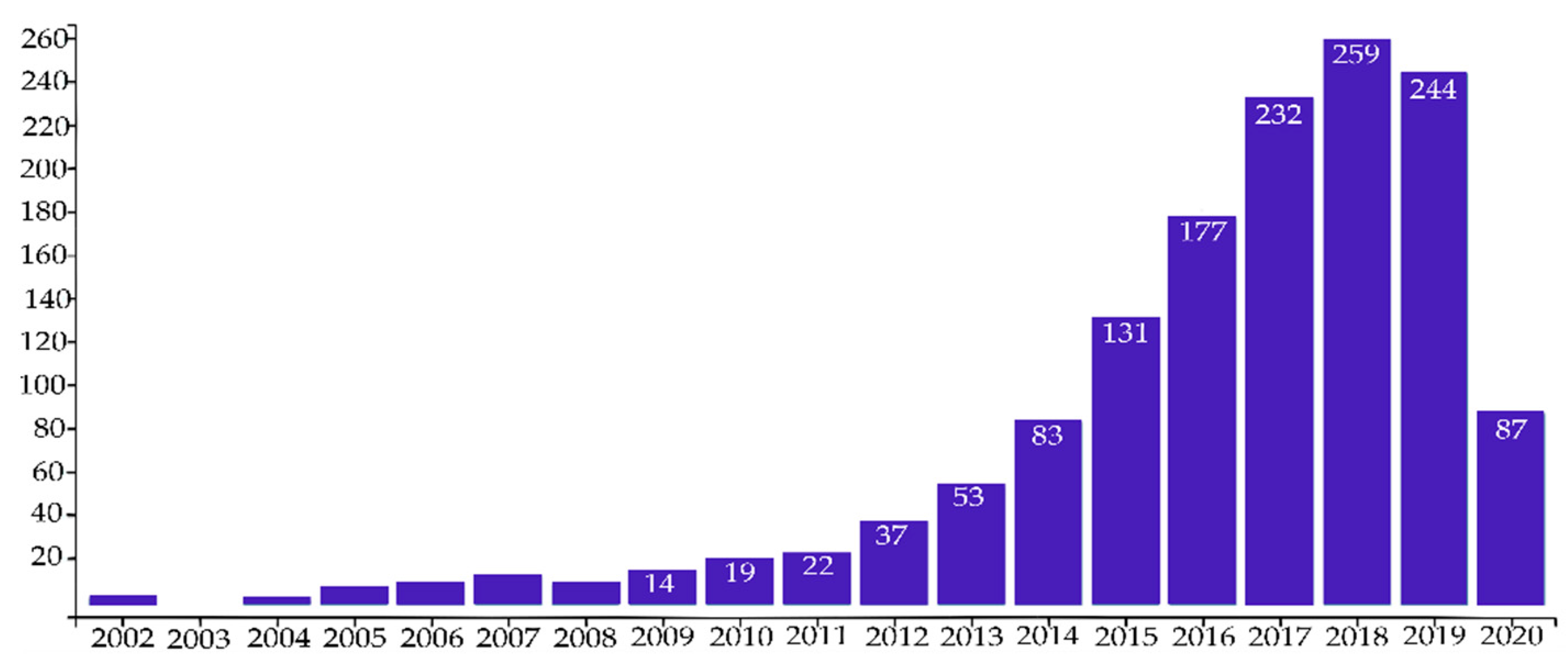


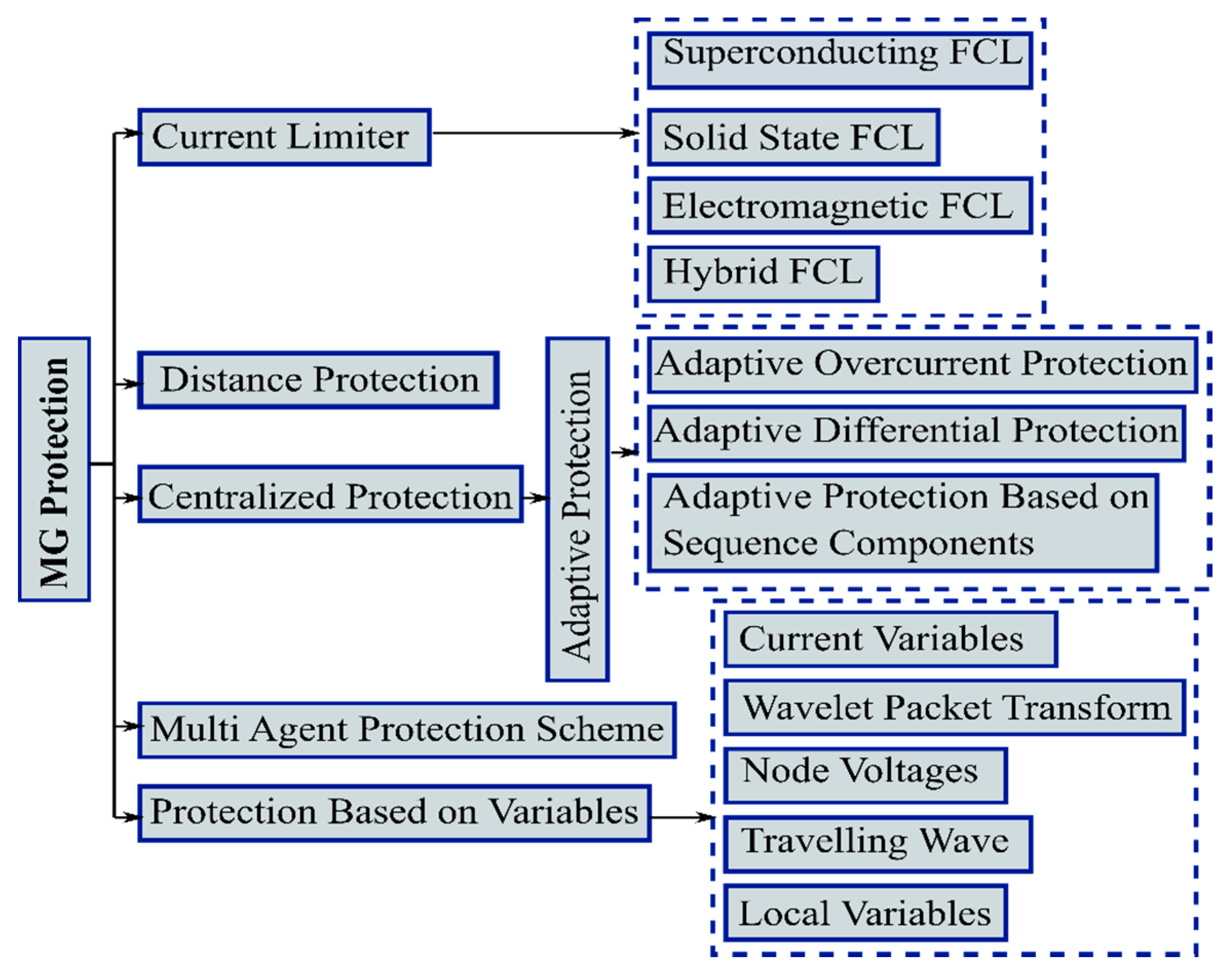
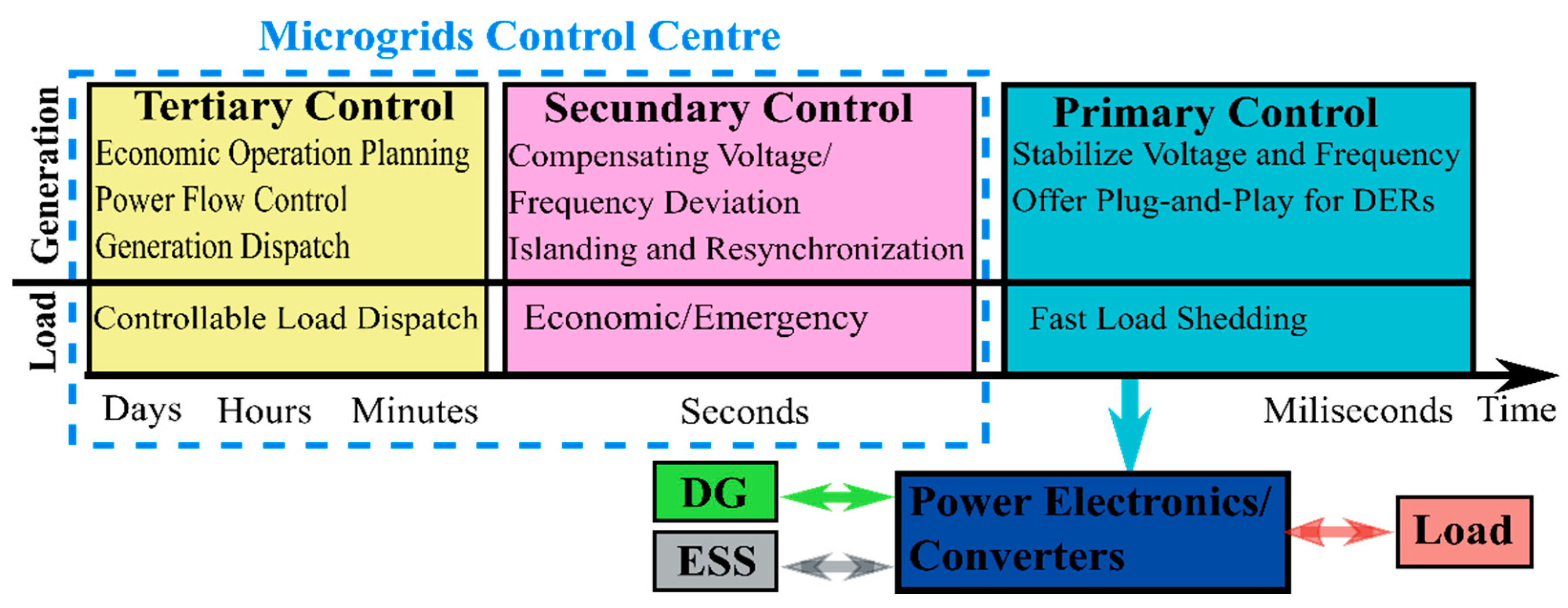

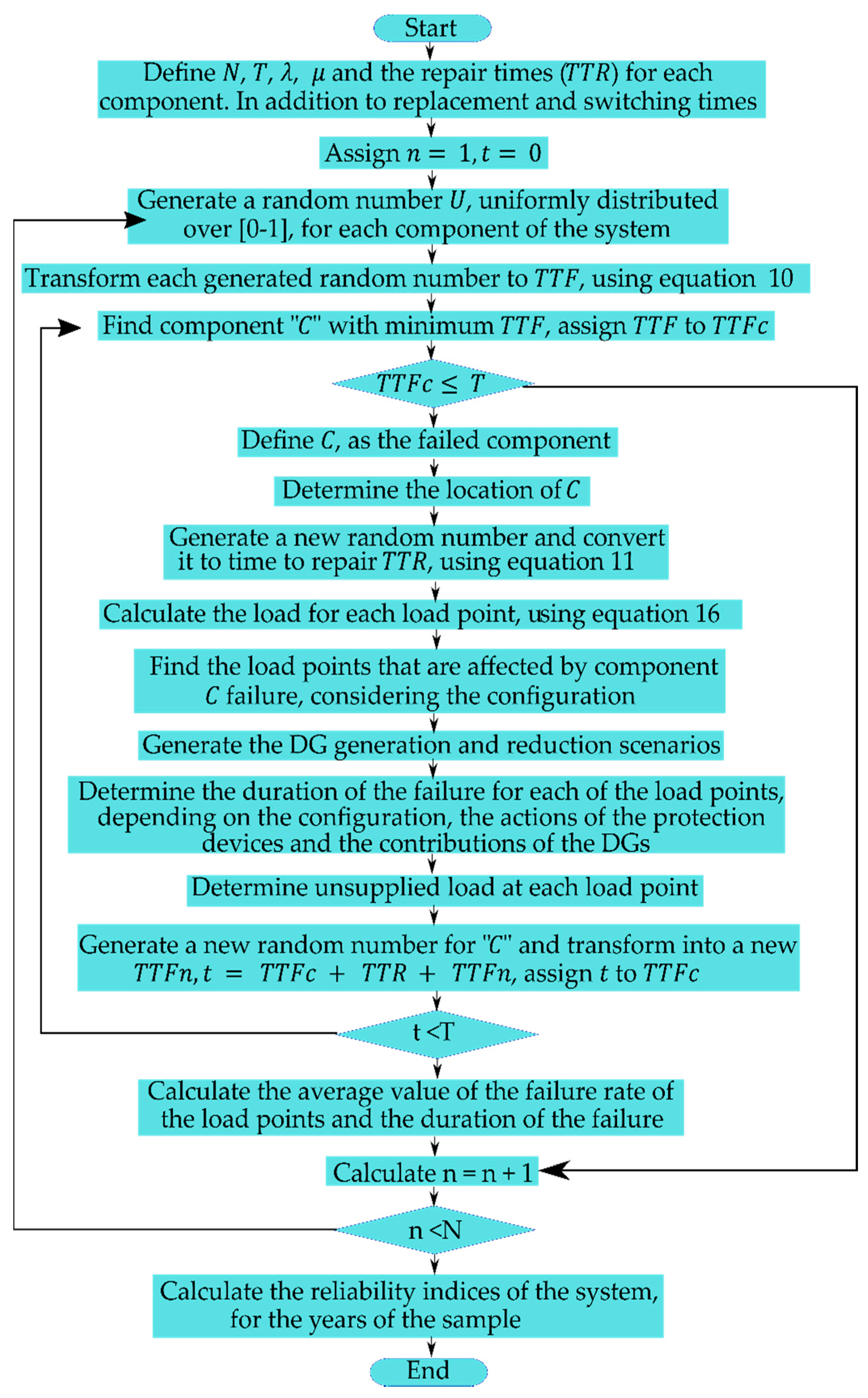
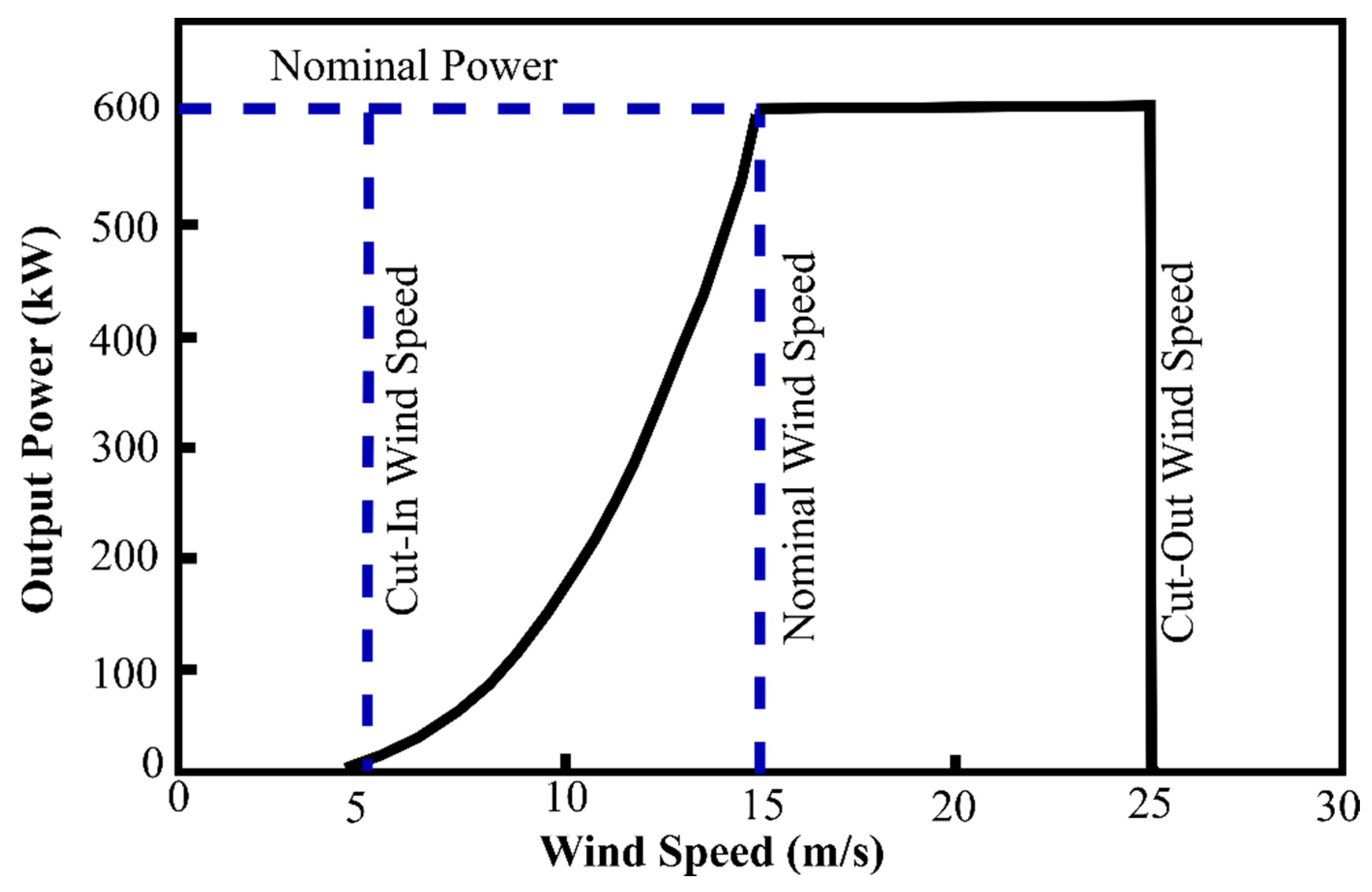
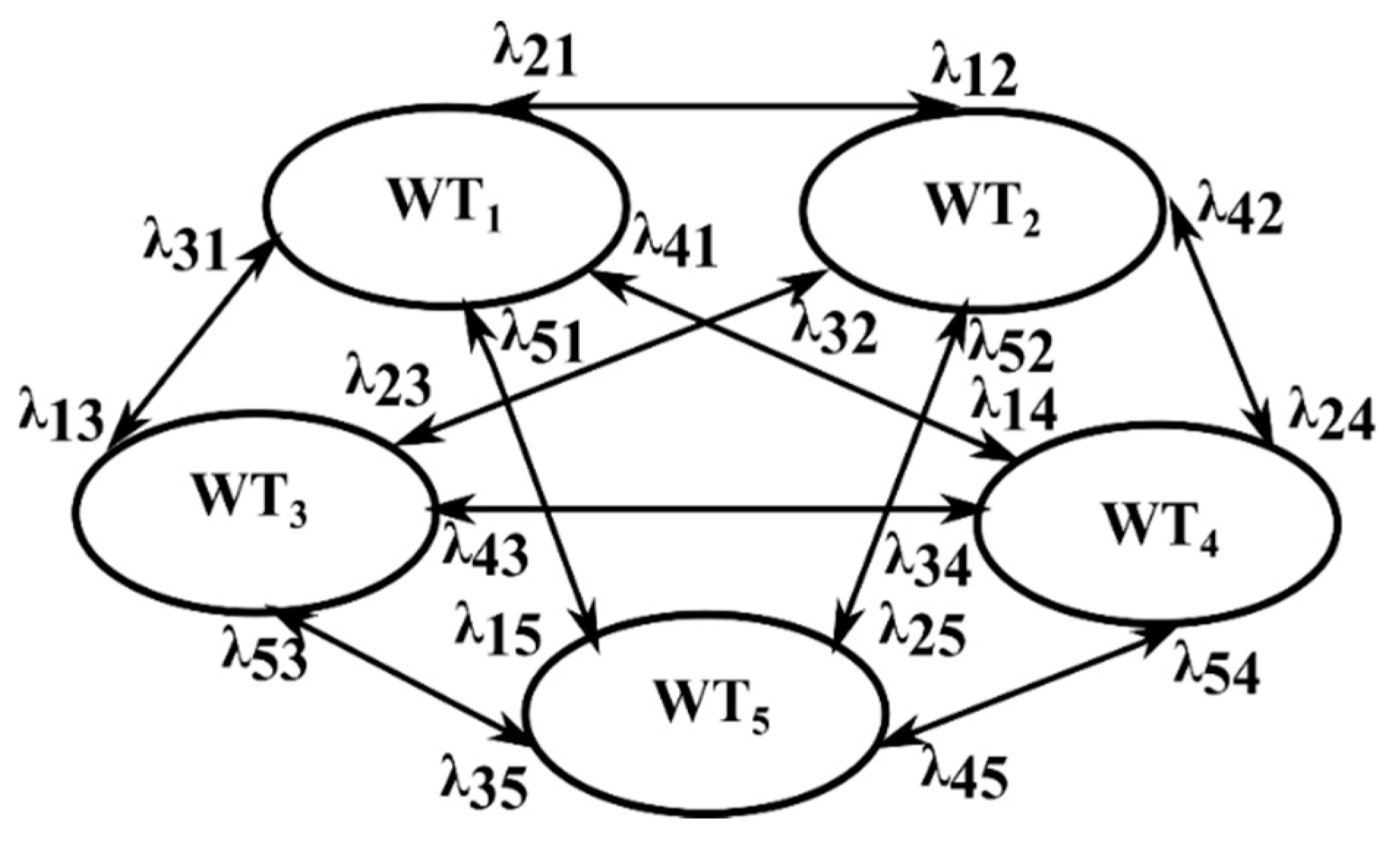
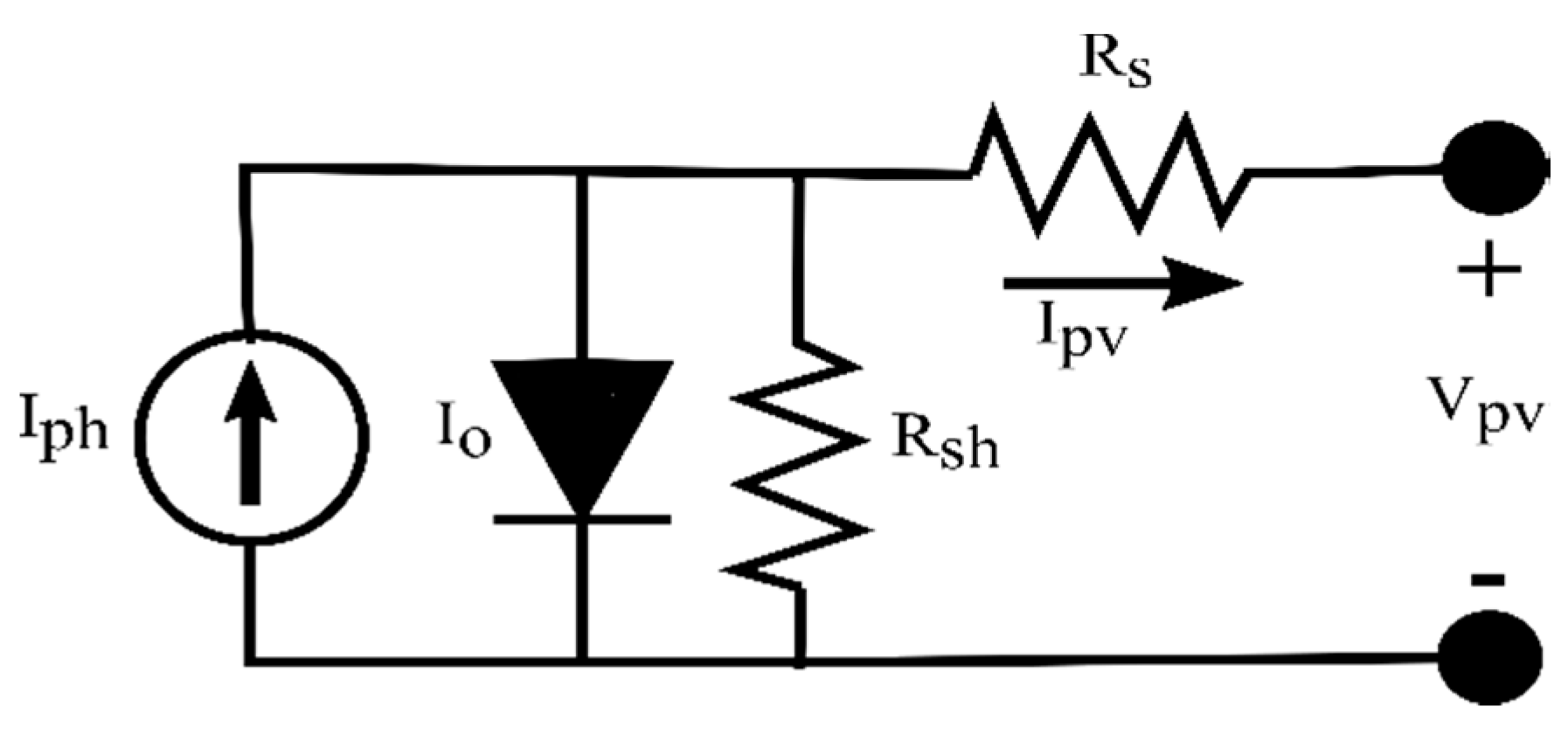
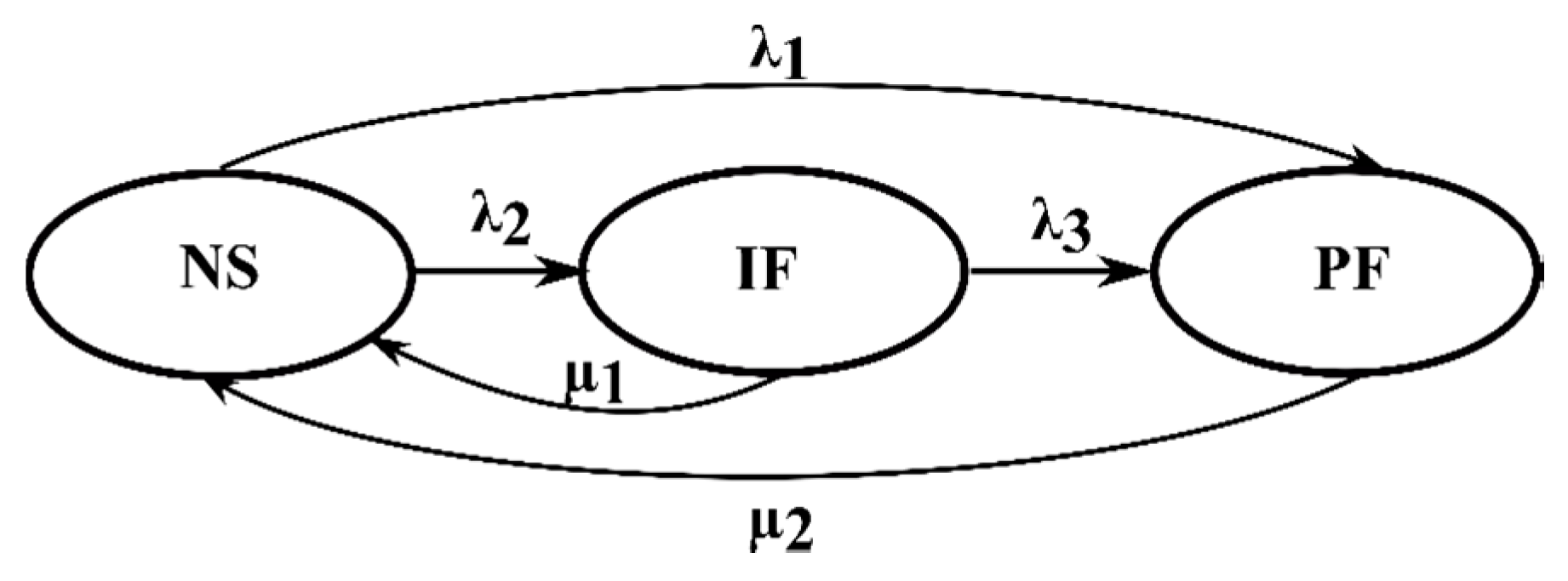

| Reference | Systems Analyzed | Implemented Technique | Calculated Indexes | Test System |
|---|---|---|---|---|
| [58] | DG | Analytical (DISREL) | SAIDI, SAIFI, CAIDI, ASAI | IEEE-RTS 34 nodes |
| Protections | ||||
| [59] | DG | SMCS | SAIDI, SAIFI, CAIDI, ASAI | IEEE-RTS 34 nodes |
| Protections | ||||
| [3] | DG (PV, WTG) | Pseudo SMCS | SAIDI, SAIFI | Real |
| ICT | ||||
| Control | ||||
| [60] | ICT (Cybernetic) | NSMCS | EENS, Others | RBTS |
| [61] | ICT (cloud storage) | NSMCS | EENS | IEEE-RTS 79 nodes |
| [62] | DG (PV, WTG, Diesel) | SMCS | EENS, SAIFI, New Indices | RBTS-Bus 6 |
| Optimization |
| Reference | Model | RA Techniques | Reliability Indexes | Test System |
|---|---|---|---|---|
| [63] | Load, DG, ESS | Analytical | SAIFI, SAIDI, CAIFI | RBTS |
| [64] | Load, DG | SAIFI, SAIDI, ASAI, ENS | Others | |
| [65] | SAIFI, SAIDI | RBTS | ||
| [66] | DG | SMCS | Others | Real |
| [67] | Analytical | SAIFI, SAIDI, ASAI, ENS | RBTS | |
| [37] | Load, DG | SMCS | ENS | Real |
| [40] | Load, DG, ESS | Others | Others | |
| [68] | DG, ESS | SAIFI, SAIDI, EENS | Real | |
| [69] | Load, DG, ESS | SMCS | AENS, EENS | |
| [70] | ENS, EENS | IEEE-RTS, RBTS | ||
| [71] | Load | SAIFI, SAIDI | Real | |
| [72] | Load, DG | IEEE-RTS, RBTS | ||
| [73] | Load, DG, ESS | SAIFI, SAIDI, ASAI, EENS | ||
| [74] | Analytical | Others | Others | |
| [75] | DG | SAIFI, SAIDI, ASAI, ENS, AENS | ||
| [76] | Load, DG | SMCS | SAIFI, SAIDI, ASAI, EENS | |
| [77] | Load, DG, ESS | Others | IEEE-RTS, RBTS | |
| [78] | Load, DG | Analytical | SAIFI, SAIDI, CAIFI, ASAI, ENS, Others | Others |
| [79] | Load, DG, ESS | SAIFI, SAIDI, ENS | ||
| [80] | Others | |||
| [81] | ENS, EENS | Real | ||
| [82] | SMCS | ENS | ||
| [83] | Analytical | SAIFI, SAIDI, ASAI, ENS | Others | |
| [84] | SAIFI, SAIDI, ENS |
| Reference | Model | DG Type | IS 2 | RA Techniques | Reliability Indexes | Test System |
|---|---|---|---|---|---|---|
| [96] | CPS | SMCS | SAIFI, SAIDI, CAIFI, AENS | Others | ||
| [97] | Analytical | SAIFI, SAIDI, CAIFI, AENS, EENS | ||||
| [98] | Others | EENS | ||||
| [99] | Load | PV, WTG | SMCS | SAIFI, SAIDI, ASAI, EENS | RBTS | |
| [100] | EENS | IEEE-RTS | ||||
| [47] | PV | Analytical, SMCS | SAIFI, SAIDI, ASAI, ENS, AENS | RBTS | ||
| [101] | Others | ENS | Real | |||
| [102] | Load, ESS | PV, WTG | MG | Analytical | Others | Others |
| [89] | New Indexes | |||||
| [91] | SMCS | Others | ||||
| [90] | Others | SAIFI, SAIDI, EENS | RBTS | |||
| [103] | PV | NSMCS | AENS, EENS | Others | ||
| [104] | PV, WTG | SMCS | EENS | |||
| [92] | PV, WTG, CEG 1, Others | Analytical | SAIFI, EENS, New Indexes | |||
| [105] | PV, WTG, CEG | Others | SAIFI, SAIDI | |||
| [106] | Load | CPS | Analytical | EENS | RBTS | |
| [107] | PV | Analytical, NSMCS | ASAI, EENS, Others | IEEE-RTS | ||
| [94] | Analytical | |||||
| [108] | Load | MG | SAIFI, SAIDI, EENS | RBTS | ||
| [109] | Load, ESS | PV, WTG | SAIFI, SAIDI, ASAI, New indices, Others | IEEE-RTS, RBTS, Real | ||
| [110] | CPS | SMCS | SAIFI, SAIDI, EENS | RBTS | ||
| [111] | Load | WTG | Others | EENS, New indices | IEEE-RTS | |
| [112] | MG | Analytical | SAIFI, SAIDI | RBTS |
| Reference | Load Type | Model | DG Type | RA Techniques | Reliability Indexes | Test System |
|---|---|---|---|---|---|---|
| [113] | Residential, commercial, industrial. | DG | PV, WTG | SMCS | ENS | RBTS |
| [37] | PV, WTG, others | Real | ||||
| [114] | Residential, commercial, others. | PV, WTG | Analytical | SAIFI, SAIDI, CAIFI, ENS, AENS. | RBTS | |
| [115] | Others. | DG | SMCS | EENS, others. | IEEE-TS | |
| [116] | PV | SAIFI, SAIDI, ENS. | Others | |||
| [117] | DG, ESS | Analytical | ENS. | IEEE-TS | ||
| [118] | DG | SAIFI, SAIDI. | Others | |||
| [63] | Residential. | DG, ESS | Analytical | SAIFI, SAIDI, CAIFI. | RBTS |
| Reference | ESS Type | Model | DG Type | RA Technique | Reliability Indexes | Test System |
|---|---|---|---|---|---|---|
| [122] | Batteries | DG | PV | Analytical | Others | Others |
| [47] | DG, Load. | Analytical and SMCS | SAIFI, SAIDI, CAIDI, ASAI, ENS, AENS. | RBTS | ||
| [123] | DG, Load. | PV, WTG. | Analytical | SAIFI, SAIDI, AENS, Others. | ||
| [120] | DG | PV | SAIFI, SAIDI, CAIDI, ASAI, ENS. | |||
| [119] | PV, WTG, Others. | Analytical, Others. | SAIFI, SAIDI, ASAI, ENS, AENS. | |||
| [124] | DG, Load. | WTG | Others | EENS, New Indices. | IEEE-TS | |
| [78] | PV | Analytical, SMCS. | SAIFI, SAIDI, ASAI, ENS. | Others | ||
| [125] | WTG | CAIDI, EENS. | IEEE-TS | |||
| [126] | Electric vehicles | SMCS | SAIFI, SAIDI, ASAI, EENS. | RBTS | ||
| [121] | PV, WTG, Others. | NSMCS | SAIFI, AENS. | IEEE-TS | ||
| [127] | SMCS | SAIFI, SAIDI, ASAI, EENS. | Others | |||
| [128] | WTG | Others | Others | Others | ||
| [39] | Batteries | PV, WTG. | SMCS | SAIFI, SAIDI, CAIDI, Others. | Real | |
| [129] | WTG, Others. | CAIDI, Others. | ||||
| [130] | PV | Analytical | Others. | Others | ||
| [131] | SMCS | SAIFI, SAIDI, EENS. | RBTS |
| Reference | Analysis Performed on the Protection Systems | RA Techniques | Test System | DG Type | Reliability Indexes |
|---|---|---|---|---|---|
| [134] | Test system includes Fuse, Circuit Breaker, Sectionalizer, Interconnection Protection, Recloser, Overcurrent Protection and Relays as protection components. Their impact on the reliability of the system was evaluated. | SMCS. | IEEE-TS | PV | SAIFI, SAIDI, CAIDI, AENS, |
| [135] | Normally open switches (NOS) are placed in the test system. Authors assessed their impact on the reliability of the system. | Own | PV, WTG, MT, FC | LOLE, LOEE, Others. | |
| [136] | A circuit breaker is located in the test system and its impact on the reliability of the system is evaluated. | Non specified | SAIFI, CAIDI | ||
| [137] | Reliability of the power system is assessed in the presence of MGs. Further, the influence on reliability of switches state and failure time are analyzed. | Analytical model, connection and influence matrix | RBTS Bus 6 | SAIFI, SAIDI, CAIDI, ASAI, EENS | |
| [138] | An algorithm for the optimal allocation of automatic switching and sectionalization devices (ASSDs) is improved and their impact on system’s reliability is evaluated. | Dynamic programming, SMCS. | Real. | SAIFI, SAIDI, EENS. | |
| [132] | The abnormal operating conditions of the protection systems (i.e., Overcurrent, Overvoltage and Sub-Voltage) are analyzed, and their impact on system’s reliability is evaluated. | Analytical model combined with a diffuse model. | Taken from [133]. | PV, WTG. | Three diffuse indexes given by the authors. |
| [139] | Authors assessed the impact of the protection systems and their operating conditions on the reliability indexes of a MG. | Grid mesh method combined with enumerative analysis. | SAIFI, SAIDI, ENS. | ||
| [140] | The effects of deficient protection schemes (focusing on the overcurrent protection scheme and monitoring) on reliability indexes are evaluated. | Integrated strategy for analysis of operating condition. | |||
| [141] | A protection coordination algorithm is proposed and its impact on the reliability of the system is assessed. | Analytical method with SMCS | RBTS- bus 6. | SAIFI, SAIDI, ENS, Others. |
| Reference | Type of Control | DG Type | RA Techniques | Reliability Indexes | Test System |
|---|---|---|---|---|---|
| [143] | Authors analyzed load control system considering the fluctuation and correlation characteristics of the renewable DGs and the load demand (advanced forecast). Three control strategies are proposed, the first one taken from other studies in which the elimination decisions of loading are obtained through the optimization of the island. When available power is not sufficient for all loads, interruptible loads will be eliminated first. A greater deficiency of energy would lead to the release of moderate loads and then to critical loads. Interrupted loads will not be restored during the period of the island until the MG is reconnected to the power grid. The other two strategies are modifications of the first, proposed by the authors. | PV, WTG. | SMCS | SAIFI, SAIDI, ASAI. | IEEE-TS, RBTS |
| [144] | A comprehensive energy management strategy (HEMS) is proposed for the management of Multi-MG systems with multiple generation resources, fixed and mobile energy storage units, as well as interruptible and non-interruptible demands. | SAIFI, SAIDI, CAIFI | RBTS | ||
| [145] | Three different types of MG power mode controls for clients were used: constant power control mode, power control mode considering the DG power limit, and optimal power control mode set. | PV | Analytical | ||
| [146] | The Spanning Tree Search algorithm is used to optimize the DS restore process, maximizing the restored load and minimizing the number of switching operations. The breadth-first search technique is used to set the time needed to restore clients. | Non specified | SAIFI, SAIDI. | Real | |
| [147] | A decentralized control is presented as a resource to avoid reliability degradation over time. Authors analyzed the centralized and decentralized control architectures for MG, from the reliability point of view. | Others | Others |
| Reference | ICT Where Analysis Was Applied | DG Type | RA Techniques | Reliability Indexes | Test System |
|---|---|---|---|---|---|
| [2] | Telecontrol/automation systems of switching devices. | Analytical | SAIFI, SAIDI. | Others | |
| [149] | Direct cybernetic power interdependencies | PV, WTG | Others | EENS, Others. | |
| [150] | Cyberphysical System | Analytical | SAIFI, SAIDI, CAIDI. | ||
| [151] | WTG | SMCS | SAIFI, SAIDI, EENS. | RBTS |
Publisher’s Note: MDPI stays neutral with regard to jurisdictional claims in published maps and institutional affiliations. |
© 2020 by the authors. Licensee MDPI, Basel, Switzerland. This article is an open access article distributed under the terms and conditions of the Creative Commons Attribution (CC BY) license (http://creativecommons.org/licenses/by/4.0/).
Share and Cite
López-Prado, J.L.; Vélez, J.I.; Garcia-Llinás, G.A. Reliability Evaluation in Distribution Networks with Microgrids: Review and Classification of the Literature. Energies 2020, 13, 6189. https://doi.org/10.3390/en13236189
López-Prado JL, Vélez JI, Garcia-Llinás GA. Reliability Evaluation in Distribution Networks with Microgrids: Review and Classification of the Literature. Energies. 2020; 13(23):6189. https://doi.org/10.3390/en13236189
Chicago/Turabian StyleLópez-Prado, Jose L., Jorge I. Vélez, and Guisselle A. Garcia-Llinás. 2020. "Reliability Evaluation in Distribution Networks with Microgrids: Review and Classification of the Literature" Energies 13, no. 23: 6189. https://doi.org/10.3390/en13236189
APA StyleLópez-Prado, J. L., Vélez, J. I., & Garcia-Llinás, G. A. (2020). Reliability Evaluation in Distribution Networks with Microgrids: Review and Classification of the Literature. Energies, 13(23), 6189. https://doi.org/10.3390/en13236189






